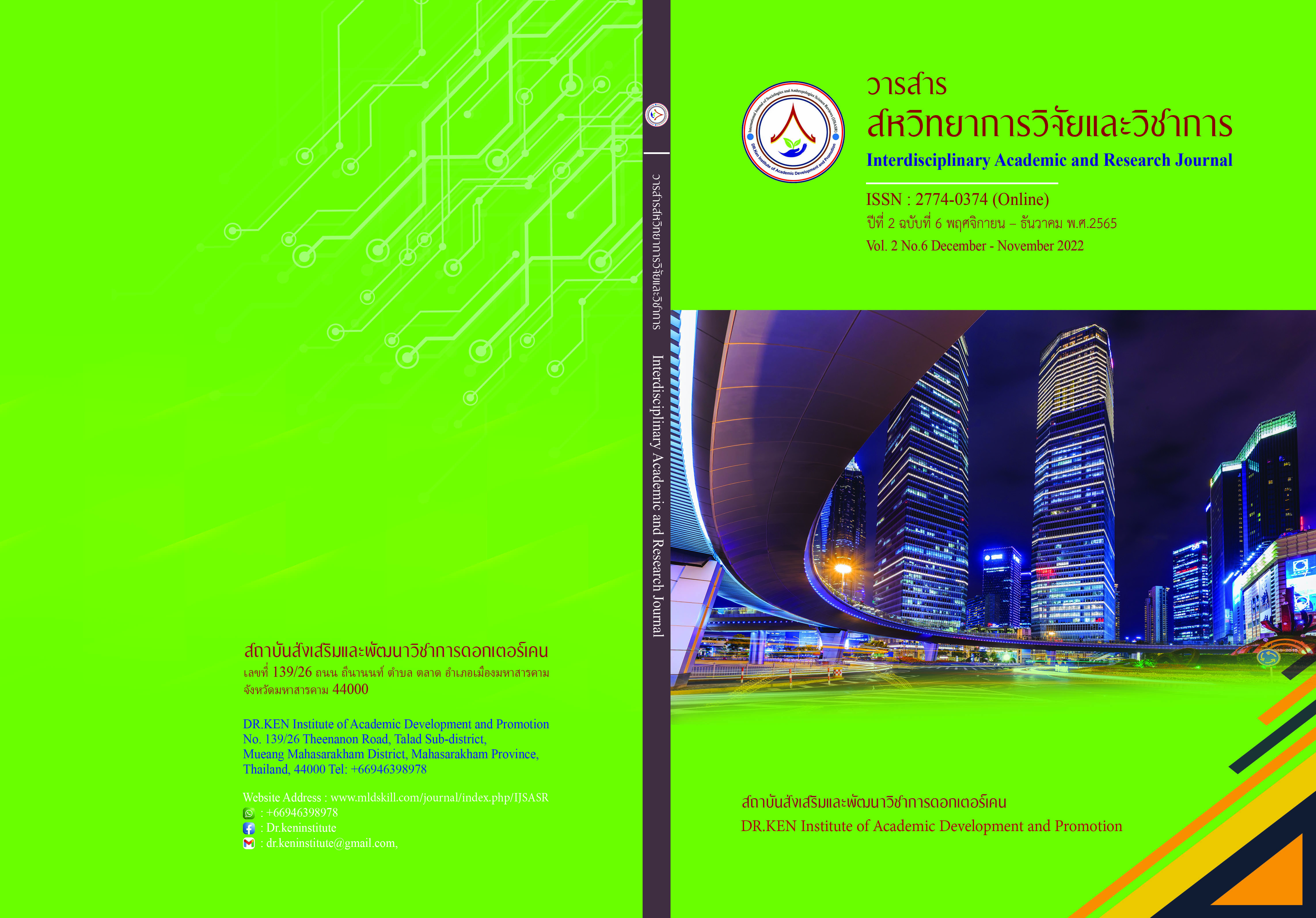Developing Strategic Leadership Components and Indicators of Mayor in the Northeast
DOI:
https://doi.org/10.14456/iarj.2022.166Keywords:
Development;, Strategic Leadership; , Mayor; , NortheastAbstract
The leader is the person who is most important to the success or failure of an organization. A leader is an influential person in commanding, assigning tasks, and supervising the work to achieve the goals of the organization. The local government organization is considered the first agency that knows the problems of the people in the area, leading the organization to be successful in serving the people in the area. Organizational leaders must have the knowledge and ability to have strategies to bring out the potential of the personnel in the organization for maximum efficiency. Therefore, this research The objectives of this research were to 1) identify the components and strategic leadership indicators of mayors in the Northeast; 2) create and develop strategic leadership indicators. of the mayors in the Northeast and 3) to examine the consistency of the relationship patterns Strategic Leadership Indicator Structure of Mayors in the Northeast Region Quantitative and qualitative research was used, divided into 2 phases: Phase 1: Creation and development of strategic leadership indicators. It is qualitative research. Research tools were structured interviews. The target group is 3 qualified persons using a specific selection method for mayors. Phase 2: Verification of strategic leadership indicators. The sample used in this research was 276 mayors in the Northeastern region using a multi-stage random sampling method. The research tool was the questionnaire on the suitability of strategic leadership indicators of mayors in the Northeast. The results showed that Strategic Leadership Indicators of Mayors in the Northeastern Region consist of 3 main components: strategic planning; Implementation of strategies and strategy tracking and evaluation. The 10 sub-components are the analysis of the organizational environment. Orientation of the organization organizational strategy formulation, planning, organization, organizational leadership, organizational control setting performance standards working with standards Implementation of improvement There are 70 indicators. The test results of the correlation model of the mayor's strategic leadership structure in the Northeast found that the Chi-Square value = 116.92 at the floor. of freedom (df) = 16, the probability approaches 1 (p) = .62, that is, the chi-square value is not statistically significant. Coherence Index (GFI) =.95 Relative Consistency Index (NFI) =.98 Model Acceptance Index (TLI) =95 Relative Consistency Index (CFI) =.98 Measurable Index Error in estimation (RMSEA) = .151. The root means square index of the residuals (RMR) = .010 shows that the Strategic Leadership Indicator Model of Mayors in the Northeast Region is consistent with empirical data.
References
กรมส่งเสริมการปกครองท้องถิ่น. (2563). สรุปข้อมูล อปท ทั่วประเทศ. [Online] http://www.dla.go.th/work/abt/index.jsp [2o กรกฎาคม 2563].
เนตรพัณณา ยาวิราช. (2552). ภาวะผู้นําและผูนําเชิงกลยุทธ (พิมพครั้งที่ 7). กรุงเทพฯ: บริษัททริปเพิ้ลกรุ๊ป จํากัด.
บุญชม ศรีสะอาด. (2554). การวิจัยเบื้องต้น (พิมพ์ครั้งที่ 9). กรุงเทพฯ: บริษัทสุวีริยาสาส์น จำกัด.
วรวรรณ สำราญใจ. (2565). แนวทางการพัฒนาภาวะผู้นำเชิงกลยุทธ์ในการบริหารโรงเรียนสู่การเป็นชุมชน แห่งการเรียนรู้ทางวิชาชีพ สังกัดสำนักงานเขตพื้นที่การศึกษาประถมศึกษาสุรินทร์ เขต 3. วารสาร มจร อุบลปริทรรศน์, 3(7), 1725-1736.
สัญญา เคณาภูมิ. (2555). เทคนิคการบริหารและภาวะผู้นำ. มหาสารคาม: คลังนานาวิทยา.
ไสว พลพุทธา. (2557). การพัฒนาตัวบ่งชี้ภาวะผู้นำเชิงกลยุทธ์ของผู้บริหารสถานศึกษาสังกัดสำนักงานเขตพื้นที่การศึกษาประถมศึกษา (วิทยานิพนธ์ปริญญาคุรุศาสารทดุษฎีบัณฑิต). สกลนคร: มหาวิทยาลัยราชภัฏสกลนคร.
Butprom, K., Muangkot, W., Loisanan, N., Namkhunthod, N., Wiwithkhunakorn, S., & Sangkhaho, W. (2021). Factors Affecting the Administration of Local Administrative Organizations: A Case Study of Local Administrative Organizations in BanKhai District, Rayong Province. International Journal of Sociologies and Anthropologies Science Reviews, 1(3), 13–22. https://doi.org/10.14456/jsasr.2021.12
Dubrin, A.J., & Andrew, J. (2007). Leadership research findings, practice, and skills (5th ed.). Boston: Houghton Mifflin.
Ireland, R.D. and Hitt, M.A. (1999). “Achieving and Maintaining Strategic Competitiveness in the Twenty-first Century: The Role of Strategic Leadership,” Academy of Management Executive. 13 (1), 43 – 57
Jedaman, P., Kenaphoom, S., & Udompan, A. (2022). Transcendental Leadership in Leader’s Strategies Management Under the 21st Century Dynamics Era. Interdisciplinary Academic and Research Journal, 2(3), 27–44. https://doi.org/10.14456/iarj.2022.24
Khanapsak, S. (2015). Customer Satisfaction with the Services of Local Administration, for the Fiscal Year 2014. Inthaninthaksin Journal. 10(1), 35-51.
Lertpaitoon, S., & Wantanakorn, M. (2003). The concept of strong management with Direct mayoral election in Thailand. Democracy Development Study Center, Bangkok: Thammasat University.
Luo, J., & Asavisanu, P. (2022). A Model for the Development of Leadership Competencies Through Participation in Extra-Curricular Activities for Undergraduate Music Students in Southern Sichuan, China. International Journal of Sociologies and Anthropologies Science Reviews, 2(4), 89–102. https://doi.org/10.14456/jsasr.2022.32
Yamanw, T., (1973). Statistics: An Introductory Analysis. 3rd edition, New York. Harper and Row Publications.
Downloads
Published
How to Cite
Issue
Section
License
Copyright (c) 2022 Shutidate Yapukdee, Saovalak Kosonkittiumporn, Yupaporn Yupas

This work is licensed under a Creative Commons Attribution-NonCommercial-NoDerivatives 4.0 International License.
Copyright on any article in the Interdisciplinary Academic and Research Journal is retained by the author(s) under the under the Creative Commons Attribution-NonCommercial-NoDerivatives 4.0 International License. Permission to use text, content, images, etc. of publication. Any user to read, download, copy, distribute, print, search, or link to the full texts of articles, crawl them for indexing, pass them as data to software, or use them for any other lawful purpose. But do not use it for commercial use or with the intent to benefit any business.
















.png)


